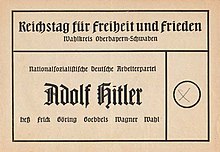Sham choice

A sham election is only a seemingly democratic election , but in fact the outcome is already predetermined. In relation to the “elected” parliament , we speak of sham parliamentarism . A sham choice is always a non-free choice (this is the opposite of a free choice ).
The function of elections is to allow the people of the state to participate in political power and to select persons to represent the people. They can also have the function of simulating participation and selection. Thus, a dictatorship tries to present itself as democratically legitimized. Sham elections can accompany the formation of a parliament, the election of an individual (such as the head of state) or the vote on an individual issue.
Freedom of choice is not given when choices are inappropriately restricted. For active suffrage, this means that the voter is threatened with coercion or manipulated. For the right to stand as a candidate, this means that not everyone is allowed to run for office.
Some dictatorships are or were officially a one-party state , such as the Soviet Union and the National Socialist German Reich . The voters should confirm the party's specified lists of candidates or give their approval in votes. Other dictatorships allow multiple parties to exist, e.g. B. So-called people 's democracies of real socialism such as the GDR , the People's Republic of China and North Korea , where a block party system formally exists. But here, too, the rulers of the communist state party, legally ruling alone under the dictatorship of the proletariat , determine beforehand what the lists of candidates for the non-communist parties and the largely communist mass organizations look like and what the options for votes are.
In addition, the voting process itself is often manipulated. For example, there were voting booths in the GDR, but anyone who actually made use of them (and thus of their right to vote secrecy ) had to fear negative reactions from those in power. After all, election fraud was used to produce the results that those in power wanted.
Elections are called semi-free if the government (or, for example, an occupying power) allows opposition candidates, but severely hinders them in the election campaign. The government also gives massive support to its own candidates. The government may decide who receives how much campaign material (paper, airtime).